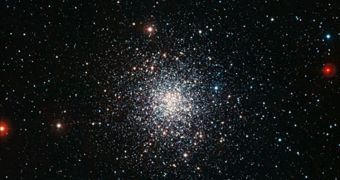A team of astronomers working out of Chile managed to collect an impressive new view of one of the Milky Way's closest companions, the globular star cluster Messier 107. The structure is located relatively nearby, at just 21,000 light-years away from our galaxy.
The object was imaged using the 2.2-meter telescope of the La Silla Observatory, which is operated in South America by the European Southern Observatory (ESO). The Wide Field Imager (WFI) instrument was used for this task.
Messier 107, which is also known among astronomers as NGC 6171, is only one of the 150+ star clusters orbiting the Milky Way at close distance. This particular structure is very compact and extremely old, and so it captured the attention of astronomers.
To an external observer, this object looks just like a bustling metropolis – thousands of stars packed together tightly, and contained within an area smaller than the distance between the Sun and Alpha Centauri. The latter is the star closest to our own.
Most of the objects contained within Messier 107 have already reached advanced stages of development, and many of them are in the last stages of their burning cycles, Daily Galaxy reports.
According to astronomers, the stars that appear to have a yellowish image in this image are in fact red dwarfs, Sun-like stars that are currently inflating and shedding the outer layers of their atmospheres.
As soon as this process is complete, all that will be left of these red giants will be helium-powered cores called white dwarfs, which will go on to burn for another 3 billion years or so. This is the same fate that awaits our parent star too.
In 4 to 5 billion years from now, it too will inflate into a red giant, consuming Mercury, Venus, Earth, and maybe even Mars. After it sheds its atmosphere, it will become a very small and dim white dwarf, that will continue to burn for ages.
Jupiter and the other gas giants will most likely stray closer to the dying star, and our solar system will resemble the multitude of such structures we see in space, with hot Jupiter-class exoplanets orbiting their small parent stars at close range.
Back to Messier 107, astronomers studied it because globular clusters provide great insight into the evolution of galaxies. NGC 6171 is about 80 light-years in diameter, and can usually be seen in the constellation of Ophiuchus.

 14 DAY TRIAL //
14 DAY TRIAL //